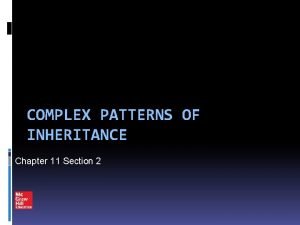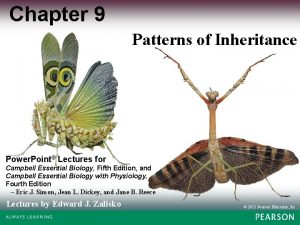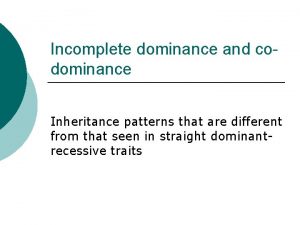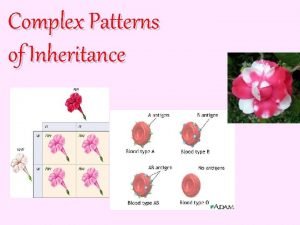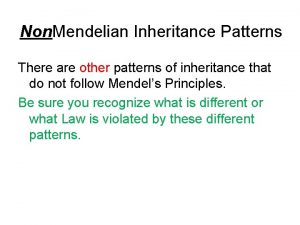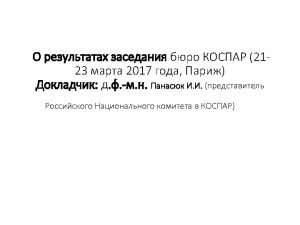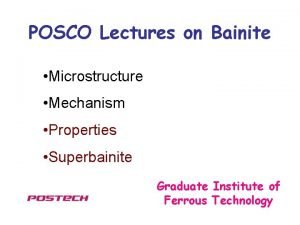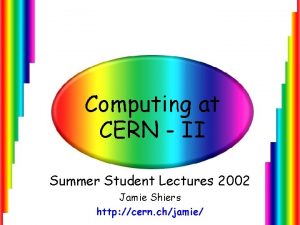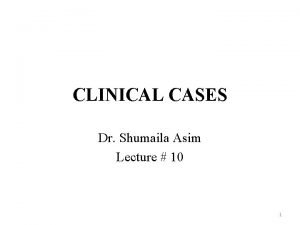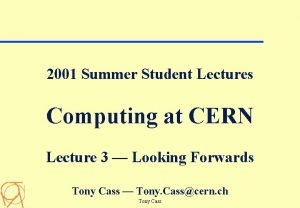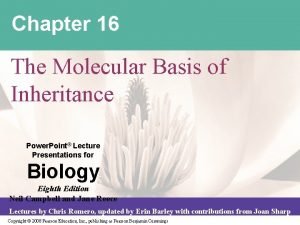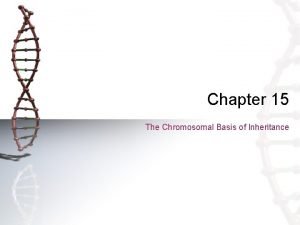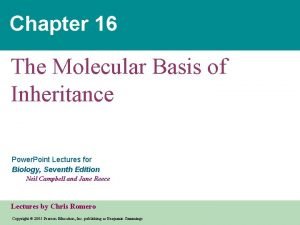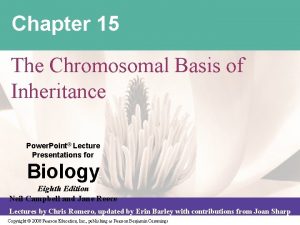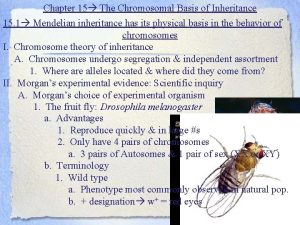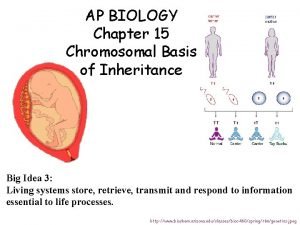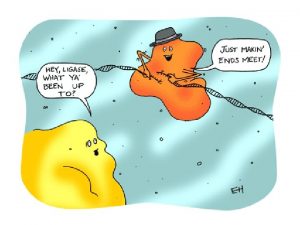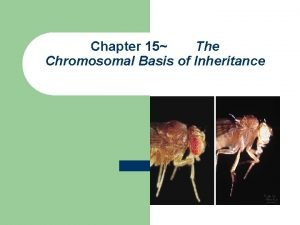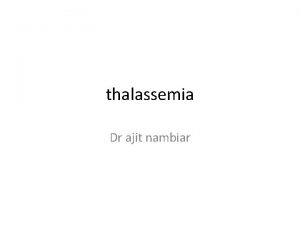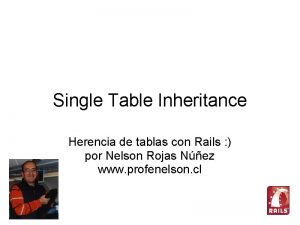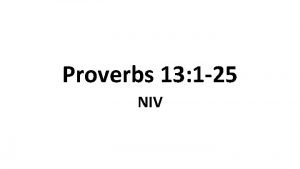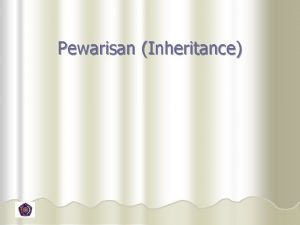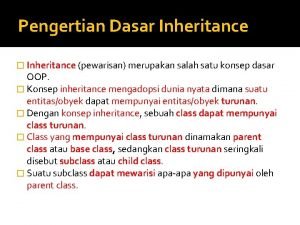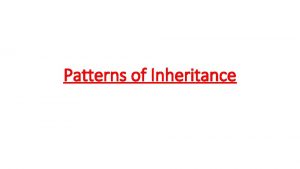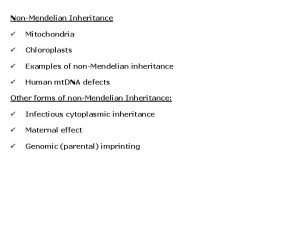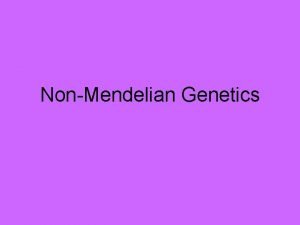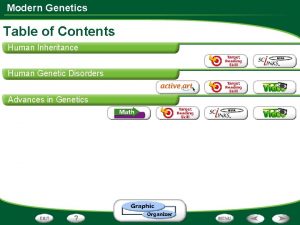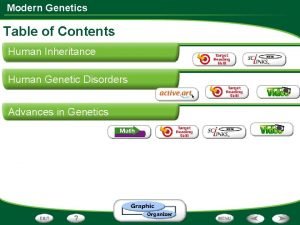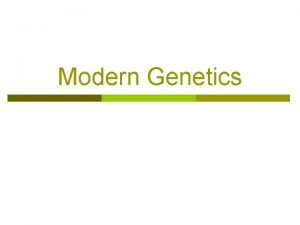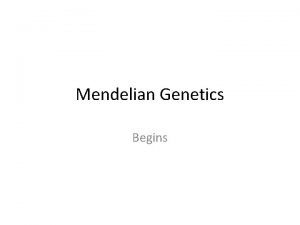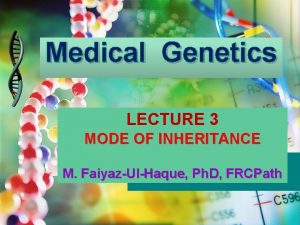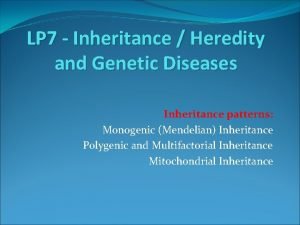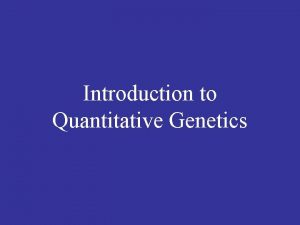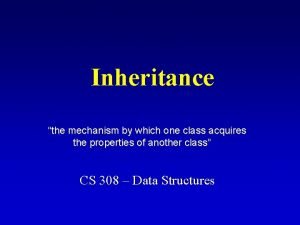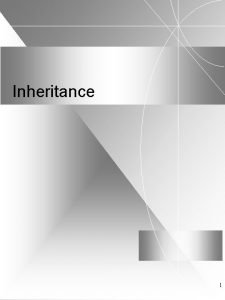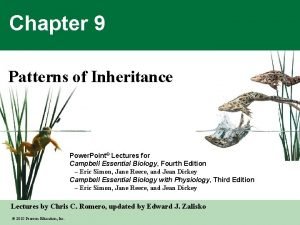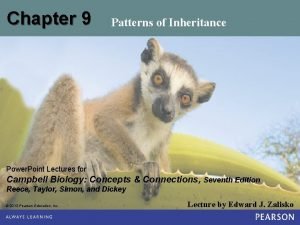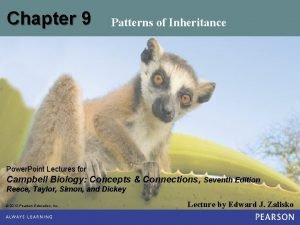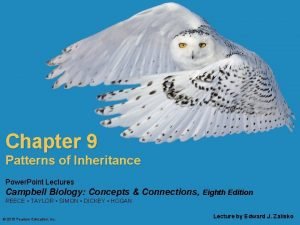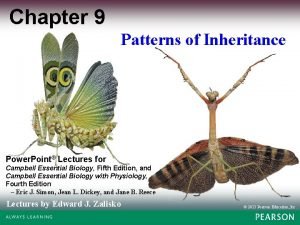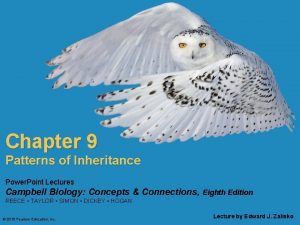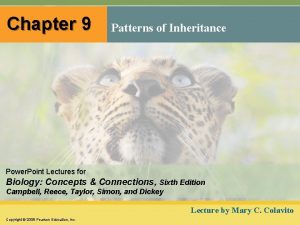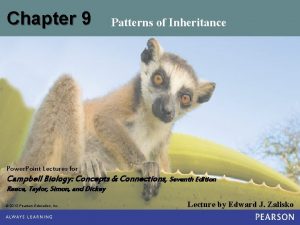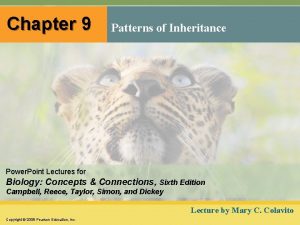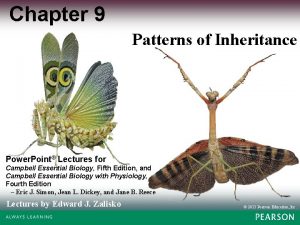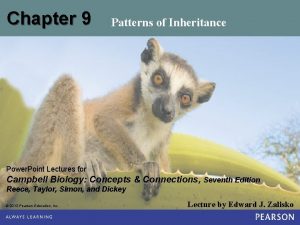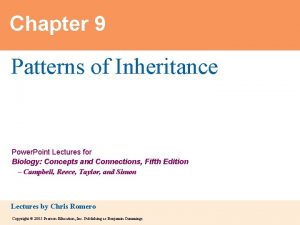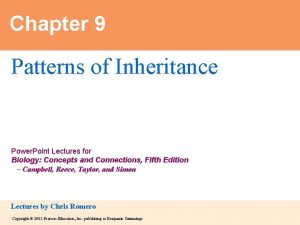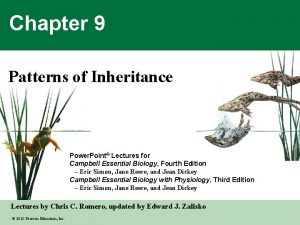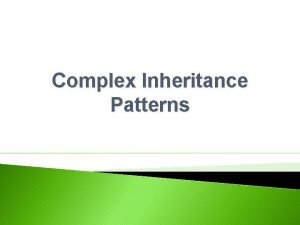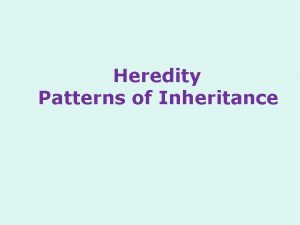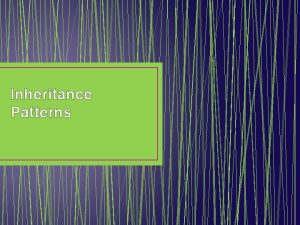Chapter 9 Patterns of Inheritance Power Point Lectures


















































































































- Slides: 114

Chapter 9 Patterns of Inheritance Power. Point® Lectures created by Edward J. Zalisko for Campbell Essential Biology, Sixth Edition, and Campbell Essential Biology with Physiology, Fifth Edition – Eric J. Simon, Jean L. Dickey, Kelly A. Hogan, and Jane B. Reece © 2016 Pearson Education, Inc.

Chapter 9: Concepts In this chapter we will learn 1. how genetic traits are passed from generation to generation and 2. how the behavior of the chromosomes account for these rules 3. Study different types of inheritance pattern 4. Predict the ratio of resulting offspring for a particular trait

Why Genetics Matters © 2016 Pearson Education, Inc. Figure 9. 0 -1

Biology and Society: Our Longest-Running Genetic Experiment • People have selected and mated dogs with preferred traits for more than 15, 000 years. • Over thousands of years, such genetic tinkering has led to the incredible variety of body types and behaviors in dogs today. • The biological principles underlying genetics have only recently been understood. © 2016 Pearson Education, Inc.

Chapter Thread: Dog Breeding © 2016 Pearson Education, Inc. Figure 9. 0 -2

Genetics and Heredity • Heredity is the transmission of traits from one generation to the next. • Genetics is the scientific study of heredity. • Gregor Mendel worked (1822 -1884) “Father of Genetics ” monk, worked in the abbey garden • in the 1860 s and argued that • parents pass on to their offspring discrete genes (which he termed “heritable factors”), • genes are responsible for inherited traits, and • genes retain their individual identities generation after generation, no matter how they are mixed up or temporarily masked. © 2016 Pearson Education, Inc.

The structure of a pea flower Mendel studied garden peas because they ü are easy to grow ü come in many readily distinguishable varieties of traits ü are easily manipulated ü can self-fertilize normally Petal Stamen (makes spermproducing pollen) Carpel (produces eggs) Figure 9. 2

In an Abbey Garden • Perhaps the most important advantage of pea plants as an experimental model was that Mendel could strictly control their reproduction. • The petals of a pea flower almost completely enclose the egg-producing organ (the carpel) and the spermproducing organs (the stamens). • Consequently, pea plants usually self-fertilize because sperm-carrying pollen grains released from the stamens land on the tip of the egg-containing carpel of the same flower.

In an Abbey Garden • Each of the characters Mendel studied occurred in two distinct forms. • A character is a heritable feature that varies among individuals (flower color). • A trait is a variant of a character (purple and white) • Each of the characters Mendel studied occurred in two distinct traits. Mendel • created purebred (true-breeding ) varieties of plants and • crossed two different purebred varieties.

Mendel’s work Pollen transferred from white flower to stigma of purple flower Bred pea plants ücross-pollinate true breeding parents üraised seed & then observed traits üallowed offspring to self-pollinate & observed next generation all purple flowers result self-pollinate ?

Mendel's technique for cross-fertilizing pea plants • When Mendel wanted to fertilize one plant with pollen from a different plant, he pollinated the plants by hand was always sure of the parentage of his new plants. Mendel ücreated purebred varieties of plants and ücrossed two different purebred varieties © 2016 Pearson Education, Inc. Removed stamens from purple flower. Parents (P) Carpel Stamens Transferred pollen from stamens of white flower to carpel of purple flower. Figure 9. 3 -s 1

Removed stamens from purple flower. Stamens Parents (P) Transferred pollen from stamens of white flower to carpel of purple flower. Carpel Pollinated carpel matured into pod. © 2016 Pearson Education, Inc. Figure 9. 3 -s 2

Removed stamens from purple flower. Parents (P) Carpel Stamens Transferred pollen from stamens of white flower to carpel of purple flower. Pollinated carpel matured into pod. Planted seeds from pod. Offspring (F 1) © 2016 Pearson Education, Inc. Figure 9. 3 -s 3

In an Abbey Garden • Hybrids are the offspring of two different purebred varieties. • The cross-fertilization itself is referred to as a genetic cross. • The parental plants are the P generation. • Their hybrid offspring are the F 1 generation. • A cross of the F 1 plants forms the F 2 generation. • Pure breeding or True breeding - varieties that produce identical offspring upon self fertilization

Mendel’s Law of Segregation • Mendel performed many experiments in which • he tracked the inheritance of characters, such as flower color, that occur as two alternative traits. • The results led him to formulate several hypotheses about inheritance. © 2016 Pearson Education, Inc.

The seven characters of pea plants studied by Mendel Dominant Recessive Flower color Pod shape Purple White Flower position Seed color Seed shape Axial Terminal Yellow Green Round Wrinkled © 2016 Pearson Education, Inc. Dominant Recessive Inflated Constricted Green Yellow Tall Dwarf Pod color Stem length Figure 9. 4

Monohybrid Crosses • Mendel performed a monohybrid cross between purebred parent plants that differ in only one character (Flower color) and found that the F 1 plants all had purple flowers. P Generation (purebred parents) Purple flowers White flowers Figure 9. 5 -s 1

P Generation (purebred parents) Purple flowers F 1 Generation (1 st filial generation) White flowers All plants have purple flowers 100% – Was the factor responsible for inheritance of white flowers now lost as a result of the cross? – By mating the F 1 plants with each other, Mendel found the answer to this question to be no. © 2016 Pearson Education, Inc. Figure 9. 5 -s 2

P Generation (purebred parents) Purple flowers White flowers F 1 Generation All plants have purple flowers (1 st filial generation) Fertilization among F 1 plants (F 1 × F 1) F 2 Generation 2 nd filial generation) 3 4 of plants have purple flowers © 2016 Pearson Education, Inc. 1 4 of plants have white flowers Figure 9. 5 -s 3

Monohybrid Crosses • Mendel figured out that the gene for white flowers did not disappear in the F 1 plants but was somehow hidden or masked when the purple-flower factor was present. • He also deduced that the F 1 plants must have carried two factors for the flower-color character, • one for purple and • one for white. © 2016 Pearson Education, Inc.

Monohybrid Crosses: What did Mendel’s findings mean? • From these results and others, Mendel developed four hypotheses: 1. There alternative versions of genes that account for variations in inherited characters. • The alternative versions of genes are called alleles. 2. For each inherited character, an organism inherits two alleles, one from each parent. • An organism that has two identical alleles for a gene is said to be homozygous for that gene. • An organism that has two different alleles for a gene is said to be heterozygous for that gene.

Monohybrid Crosses: What did Mendel’s findings mean? 3. If the two alleles of an inherited pair differ, üthen one determines the organism’s appearance and is called the dominant allele, and üthe other has no noticeable effect on the organism’s appearance and is called the recessive allele. • Some traits mask others • purple & white flower colors are separate traits that do not blend • purple x white ≠ light purple masked white • Geneticists use uppercase italic letters (such as P) to represent dominant alleles and lowercase italic letters (such as p) to represent recessive alleles.

Monohybrid Crosses 4. Gametes (sperm or egg) carries only one allele for each inherited character because üthe two alleles for a character segregate (separate) from each other during the production of gametes. üThis statement is called the law of segregation. When sperm and egg unite at fertilization, each contributes its alleles, restoring the paired condition in the offspring. • Figure 9. 6 illustrates Mendel’s law of segregation, which explains the inheritance pattern shown in Figure 9. 5.

Monohybrid Crosses Do Mendel’s hypotheses account for the 3: 1 ratio he observed in the F 2 generation? • A Punnett square highlights - the four possible combinations of gametes and - offspring that result from each cross. - each square represents an equally probable product of fertilization • Geneticists distinguish between an organism’s physical appearance and its genetic makeup. - An organism’s physical traits are its phenotype (3 : 1 ratio) - An organism’s genetic makeup is its genotype (list of the organism’ genes and their exact DNA position) (1: 2: 1 ratio)

The law of segregation P Generation Genetic makeup (alleles) Alleles carried by parents MEIOSIS Gametes Purple flowers 2 n PP White flowers pp 2 n All p n All P n F 1 Generation (hybrids) Purple flowers All Pp 2 n Alleles segregate Gametes Reginald Punnett (1875 - 1967) An explanation of Monohybrid results using a Punnett square 1 2 1 p 2 P F 2 Generation (hybrids) Sperm from F 1 plant Eggs from F 1 plant P p PP Pp Pp pp P p Phenotypic ratio Genotypic ratio 3 purple : 1 white 1 PP : 2 Pp : 1 pp

Practice • A true-breeding plant that produces yellow seeds is crossed with a true-breeding plant that produces green seeds. The seeds of all of the offspring are yellow. Why? A) The yellow allele is recessive to the green allele. B) All of the offspring are homozygous yellow. C) The yellow allele is dominant to the green allele. D) The alleles are codominant. E) Yellow is an easier color to produce.

Genetic Alleles and Homologous Chromosomes üA gene locus is a specific location of a gene along a chromosome üHomologous chromosomes o Have genes at specific loci. o have alleles (alternate versions) of a gene at the same locus. o two chromosomes may bear either identical alleles or different ones at any one locus Gene loci P Dominant allele a B a b Homologous chromosomes P Genotype: PP Homozygous for the dominant allele aa Homozygous for the recessive allele Bb Recessive allele Heterozygous with one dominant and one recessive allele

Practice An individual who is homozygous _______. A) expresses the dominant trait B) carries two different alleles for a gene C) is a carrier of a genetic disorder D) carries two copies of the same allele for a gene E) expresses the recessive trait

Practice An allele is _____________. a. a type of chromosome b. the dominant form of a gene c. a variety of pea plant used by Mendel d. an alternative version of a gene e. the recessive form of a gene

Genotype vs. phenotype Difference between how an organism “looks” & its genetics vphenotype - description of an organism’s trait vgenotype - description of an organism’s genetic makeup X P Explain Mendel’s results using …dominant & recessive …phenotype & genotype purple white F 1 all purple

Making crosses Can represent alleles as letters üflower color alleles ütrue-breeding purple-flower peas ütrue-breeding white-flower peas X P purple F 1 all purple white P or p PP pp PP x pp Pp

Punnett squares Pp x Pp 1 st Aaaaah, phenotype & genotype can have different ratios generation (hybrids) % genotype male / sperm female / eggs P p PP Pp P PP Pp pp % phenotype 25% 75% 50% Pp pp 25% 1: 2: 1 3: 1

The Rules of Probability • Mendel’s strong background in mathematics helped him understand patterns of inheritance. • For instance, he understood that genetic crosses obey the rules of probability—the same rules that apply when tossing coins, rolling dice, or drawing cards. • For each toss of the coin, the probability of heads is ½ every time – the outcome of any given toss is unaffected by what has happened on previous attempts (toss is an independent event). • If 2 coins are tossed simultaneously, the outcome for each is independent, unaffected by the other coin. What is the chance that both coins land heads-up ? • the probability of dual event is the product of the separate probabilities of the independent events – ½ x ½ = ¼. • The rule of multiplication states that the probability of a compound event is the product of the separate probabilities of the independent events.

Segregation of alleles and fertilization as chance events F 1 Genotypes Bb female Bb male × Formation of sperm Formation of eggs F 2 Genotypes BB= 25%; bb= 25%; Bb=50% The rule of addition for heterozygote (Bb) üInside the table you add probabilities 1/4 + 1/4= 1/2 © 2016 Pearson Education, Inc. Male gametes 1 2 B B Female gametes Formation of gametes is like flipping a coin (Head or tail) Chance of having a head or a tail is ½ The rule of multiplication üMultiply from the outside of the table to the inside 1 2 B B 1 2 b B 1 4 ( 12 × 12 ) 1 2 Figure 9. 11 b b B 1 4 b b b 1 4

Genotypes üHomozygous = same alleles = PP, pp üHeterozygous = different alleles = Pp homozygous dominant homozygous recessive

Phenotype vs. genotype 2 organisms can have the same phenotype but have different genotypes purple PP homozygous dominant purple Pp heterozygous

Mendel’s Law of Independent Assortment • A dihybrid cross is the mating of parental varieties differing in two characters. • Mendel studied inheritance of pattern of two characters one at a time as in a monohybrid ratio üseed color (yellow is dominant to green) üseed shape (round shape is dominant to wrinkled seed) • What would result from a dihybrid cross? Two hypotheses are possible

Mendel’s Law of Independent Assortment • Dependent assortment: • If the genes for the two characters were inherited together, then • the F 1 hybrids would produce only the same two kinds of gametes that they received from their parents, and • the F 2 generation would show a 3: 1 phenotypic ratio. • Independent assortment: • If, however, the two seed characters sorted independently, then • the F 1 generation would produce four gamete genotypes (RY, r. Y, Ry, and ry) in equal quantities, and • the F 2 generation would have nine different genotypes producing four different phenotypes in a ratio of 9: 3: 3: 1.

Testing alternative hypotheses for gene assortment in a dihybrid cross (b) Hypothesis: Independent assortment (a) Hypothesis: Dependent assortment P Generation RRYY Gametes RRYY rryy RY ry Rr. Yy Gametes F 1 Generation rryy RY ry Rr. Yy Were the two characters transmitted to offspring as a package (capital letter staying together), or was each character inherited independently of each other (consider all possible combinations )? © 2016 Pearson Education, Inc. Figure 9. 8 -1

(a) Hypothesis: Dependent assortment (b) Hypothesis: Independent assortment P Generation RRYY Gametes RRYY rryy Gametes ry RY F 1 Generation rryy ry RY Rr. Yy F 2 Generation Sperm 1 4 Sperm 1 2 RY 1 2 ry RY Eggs 1 2 ry Predicted results Contradict hypothesis (not actually seen) © 2016 Pearson Education, Inc. 1 4 RY 1 4 r. Y Eggs 1 4 Ry 1 4 ry RY 1 4 r. Y 1 4 Ry 1 4 ry RRYY Rr. YY RRYy Rr. YY rr. YY Rr. Yy rr. Yy 9 16 Yellow round RRYy Rr. Yy RRyy Rryy 3 16 Green round Rr. Yy rr. Yy Rryy rryy Actual results (support hypothesis) 3 16 1 16 Yellow wrinkled Green wrinkled Figure 9. 8

© 2016 Pearson Education, Inc. Figure 9. 8 -4

Mendel’s Law of Independent Assortment • Mendel’s dihybrid cross supported the hypothesis that each pair of alleles segregates independently of the other pairs during gamete formation. • Thus, the inheritance of one character has no effect on the inheritance of another. • This is called Mendel’s law of independent assortment. • Independent assortment is seen in the inheritance of two characters in Labrador retrievers. © 2016 Pearson Education, Inc.

Practice In a certain plant, the alleles A, B, and C are dominant to the alleles a, b, and c. A plant with the genotype AABbcc will have the same phenotype as the plant with the genotype _____. ( Heritable Variation and Patterns of Inheritance) a. AAbbcc b. aabbcc c. Aa. BBcc d. AABBCc e. none of the above © 2016 Pearson Education, Inc.

Practice Assume tall (T) is dominant to dwarf (t). If a homozygous dominant individual is crossed with a homozygous dwarf, the offspring will _____. ( Heritable Variation and Patterns of Inheritance) a. all be intermediate in height b. all be tall c. 1/2 tall and 1/2 dwarf d. be 3/4 tall and 1/4 dwarf e. all be short © 2016 Pearson Education, Inc.

Independent assortment of genes in Labrador retrievers Blind dog Black coat, normal vision B_N_ Phenotypes Black coat, blind (PRA) Genotypes B_nn (a) Possible phenotypes of Labrador retrievers Blind dog Chocolate coat, normal vision bb. N_ Chocolate coat, blind (PRA) bbnn Mating of double heterozygotes (black coat, normal vision) Bb. Nn Blind Phenotypic ratio of offspring 9 black coat, normal vision (b) A Labrador dihybrid cross © 2016 Pearson Education, Inc. 3 black coat, blind (PRA) 3 chocolate coat, normal vision 1 chocolate coat, blind (PRA)

Dominant phenotypes It is not possible to determine the genotype of an organism with a dominant phenotype by looking at it. PP? Pp? © 2016 Pearson Education, Inc. So how do you figure out the genotype?

Using a Testcross to Determine an Unknown Genotype • A testcross is a mating between an individual of dominant phenotype (but unknown genotype) and a homozygous recessive individual. x is it PP or Pp? pp

Test cross x PP P x pp p p Pp P 100% P Pp Pp p p Pp Pp 50%: 50% 1: 1 pp pp

A Labrador retriever testcross Testcross B_ Genotypes bb Two possible genotypes for the black dog: BB Gametes B b Offspring Bb or Bb All black b Bb bb 1 black : 1 chocolate

Practice A testcross is applied to determine a. whether the dominance of the trait is incomplete. b. None of these c. whether the parent displaying the dominant phenotype is a dominant heterozygote or dominant homozygote. d. the genotype of the parent that displays the recessive phenotype. e. whether a trait is dominant or recessive.

Practice Suppose we have a pea plant with purple flowers, determined by the dominant allele P. How might you determine whether the plant is homozygous (PP) or heterozygous (Pp)? ( Heritable Variation and Patterns of Inheritance) a. Cross the plant with a true-breeding purple plant. b. Attempt to cross the plant with a pink-flowered snapdragon. c. Examine the plant's chromosomes with a microscope. d. Perform a testcross: Cross the plant with a known heterozygote, Pp. e. Perform a testcross where you cross the plant with a white plant, which must be homozygous recessive, or pp.

Family Pedigrees – normal or – more common • Wild-type traits are – those seen most often in nature and – not necessarily specified by dominant alleles RECESSIVE TRAITS • Dominant traits are not necessarily DOMINANT TRAITS • Mendel’s principles apply to the inheritance of many human traits. Freckles No freckles Widow’s peak Free earlobe Straight hairline Attached earlobe Examples of inherited traits controlled by single gene

Family Pedigrees • How can human genetics be studied? • Geneticists • analyze the results of matings that have already occurred and • assemble this information into a family tree, called a pedigree. • A family pedigree • can deduce which trait is recessive • can also deduce the genotype of most of the people in pedigree • shows the history of a trait in a family and • allows geneticists to analyze human traits. • Mendel’s laws enable us to deduce the genotypes for most of the people in the pedigree.

First generation (grandparents) Second generation (parents, aunts, and uncles) Third generation (brother and sister) Female Male Attached © 2016 Pearson Education, Inc. Aaron Ff Betty Ff Evelyn Fred Gabe FF ff ff or Ff Cletus ff Hal Ff Ina Ff Kevin ff Lisa FF or Ff Debbie Ff Julia ff Female Male Free Figure 9. 13 -1

Human Disorders Controlled by a Single Gene Many human traits show simple inheritance patterns and are controlled by single genes on autosomes (not the sex chromosomes X or Y ) © 2016 Pearson Education, Inc.

Recessive Disorders • Most human genetic disorders are recessive. • Individuals who have the recessive allele but appear normal are carriers of the disorder. • Using Mendel’s laws, we can predict the fraction of affected offspring that is likely to result from a marriage between two carriers. © 2016 Pearson Education, Inc.

Parents Hearing Dd Offspring D Sperm d Suppose, 2 heterozygotes carriers have a child. What is the probability that the child will be deaf? D DD Hearing Dd Hearing (carrier) dd Deaf Eggs d Figure 9. 14 © 2016 Pearson Education, Inc.

Recessive Disorders • Cystic fibrosis is • the most common lethal genetic disease in the USA and • occurs when mucus build up in many organs • caused by a recessive allele carried by about 1 in 31 Americans. • Prolonged geographic isolation of certain populations can lead to inbreeding, the mating of close relatives. • It is relatively unlikely that two carriers of a rare allele will meet and mate. • Inbreeding increases the chance of offspring that are homozygous for a harmful recessive trait.

Dominant Disorders • A number of human disorders are caused by dominant alleles. • Achondroplasia is a form of dwarfism. • The homozygous dominant genotype (AA) causes death of the embryo. • Only heterozygotes (Aa), individuals with a single copy of the defective allele, have this disorder. • This also means that a person with achondroplasia has a 50% chance of passing the condition on to any children. © 2016 Pearson Education, Inc. Achondroplasia, a dominant trait

Parents Normal (no achondroplasia) dd d D Sperm Dwarf (achondroplasia) Dd d Dd Dwarf dd Normal Eggs d © 2016 Pearson Education, Inc. Figure 9. 15

Dominant Disorders • Dominant alleles that cause lethal disorders are much less common than lethal recessive alleles. • One example is the allele that causes Huntington’s disease, a degeneration of the nervous system that usually does not begin until middle age. • Once the deterioration of the nervous system begins, it is irreversible and inevitably fatal. • Because the allele for Huntington’s disease is dominant, any child born to a parent with the allele has a 50% chance of inheriting the allele and the disorder. © 2016 Pearson Education, Inc.

Genetic Testing • Today many tests can detect the presence of disease -causing alleles. • Most genetic tests are performed during pregnancy if the prospective parents are aware that they have an increased risk of having a baby with a genetic disease. • In amniocentesis, a physician uses a needle to extract about 2 teaspoons of the fluid that bathes the developing fetus. • In chorionic villus sampling, a physician inserts a narrow, flexible tube through the mother’s vagina and into her uterus, removing some placental tissue.

Genetic Testing • Newer genetic screening procedures involve isolating tiny amounts of fetal cells or DNA released into the mother’s bloodstream. These newer technologies are gradually replacing more invasive screening methods because they • are more accurate and • can be performed earlier than other tests. • Once cells are obtained, they can be screened for genetic diseases. • Patients seeking genetic testing should receive counseling both before and after to explain the test and to help them cope with the results. © 2016 Pearson Education, Inc.

Extending Mendelian genetics Mendel worked with a simple system üpeas are genetically simple ümost traits are controlled by single gene üeach gene has only 2 version o 1 completely dominant (A) o 1 recessive (a) § But its usually not that simple!

Variations on Mendel’s Laws • Mendel’s two laws explain inheritance in terms of genes that are passed along from generation to generation according to simple rules of probability. • These laws are valid for all sexually reproducing organisms. • But Mendel’s laws stop short of explaining some patterns of genetic inheritance. • In fact, for most sexually reproducing organisms, the observed inheritance patterns are more complex. Additional tests have revealed some special cases of genetic inheritance : 1. 2. 3. 4. Incomplete dominance Multi-allelic dominance Single genes affecting multiple traits (pleiotropy) Polygenic inheritance

1. Incomplete dominance in Plants and People Snapdragons ü F 1 hybrids have an appearance in between the phenotypes of the two parents. This is the result of incomplete dominance. ü Pure red and pure white snapdragons produce allpink offspring (mixed color). ü Two alleles produce three phenotypes ? ü Differences & similarities with the Mendelian genetics? P Generation White rr Red RR Gametes R r F 1 Generation Pink Rr 100% Gametes F 2 Generation 1 2 R Eggs 1 r 2 1 1 R 2 r 2 Sperm 1 1 R 2 r 2 RR Rr Rr rr

Incomplete dominance P X true-breeding red flowers 1 st true-breeding white flowers 100% pink flowers 100% generation (hybrids) self-pollinate 25% red 2 nd generation 50% pink 25% white 1: 2: 1

Incomplete dominance RW x RW male / sperm female / eggs R R W W RR RW RW WW % genotype RR RW % phenotype 25% 50% RW WW 25% 1: 2: 1

Incomplete Dominance in Plants and People • Hypercholesterolemia • is a human trait that is incompletely dominance • is characterized by dangerously high levels of cholesterol in the blood. • heterozygotes have blood cholesterol levels about twice normal, while • homozygotes have about five times the normal amount of blood cholesterol and may have heart attacks as early as age 2.

PHENOTYPE GENOTYPE Incomplete dominance in People HH Homozygous for ability to make LDL receptors Hh Heterozygous hh Homozygous for inability to make LDL receptors LDL receptor © 2016 Pearson Education, Inc. Cell Normal Mild disease Make half of the Receptors Low diet in cholesterol can alleviate Severe disease Unable to lower excess cholesterol Low diet in cholesterol + something else

Practice In snapdragons, heterozygotes have pink flowers, whereas the dominant and recessive homozygotes have red and white flowers, respectively. When red -flowered plants are crossed with white-flowered plants, what percentage of the progeny will have pink flowers © 2016 Pearson Education, Inc.

Practice Andalusian chickens with the genotype CBCB are black, those with the genotype CWCW are white, and those with the genotype CBCW are gray. What is the expected phenotypic ratio of a CBCB x CBCW cross? a. 1 black : 1 white b. 3 black : 1 white c. 1 black : 2 gray : 1 white d. 3 gray : 1 white e. 1 black : 1 gray © 2016 Pearson Education, Inc.

ABO Blood Groups: An Example of Multiple Alleles and Codominance • The ABO blood groups in humans are an example of multiple alleles and Codomiance. • The immune system produces blood proteins called antibodies that bind specifically to foreign carbohydrates. • If a donor’s blood cells have a carbohydrate (A or B) that is foreign to the recipient, the blood cells may clump together, potentially killing the recipient. • The clumping reaction is the basis of a blood-typing lab test. • The human blood type alleles IA and IB are codominant, meaning that both alleles are expressed in heterozygous individuals who have type AB blood. • both A & B alleles are dominant over i allele © 2016 Pearson Education, Inc.

2. Multiple allele and Codominance – There are three common alleles for ABO blood type • Allele IA for the ability to make substance A • Allele IB for the ability to make substance B • Allele i for the ability to make neither of the substance – Four blood groups were made from 3 different alleles • type A : IA IA homozygote dominant for A or IAi heterozygote for A • type B : IB IB homozygote dominant for B or IBi heterozygote for B • type AB : IA IB heterozygote for A and B; codominance • type O : ii (recessive) – The human blood type alleles IA and IB exhibit codominance: Both alleles are expressed in the phenotype The genes code for different sugars on the surface of red blood cells © 2016 Pearson Education, Inc.

Multiple Alleles for the ABO blood group Blood Group Genotypes (Phenotype) A B IAIA or IAi IBIB or IBi Red Blood Cells Antibodies Present in Blood Reactions When Blood from Groups Below Is Mixed with Antibodies from Groups at Left A B AB O Carbohydrate A Anti-B clotting Carbohydrate B Anti-A clotting AB IAIB Universal recipient — O ii Universal donor Anti-A Anti-B clotting I = for immune factor can be either A or B; IA = allele A; IB = allele B i = absence of the immune factor IAIB is codominance; IA and IB are two codominant alleles Three alleles give four phenotypes © 2016 Pearson Education, Inc. clotting

Practice If one parent is blood type AB and the other is type O, what fraction of their offspring will be blood type A? a. 0. 5 b. 0. 25 c. 0. 75 d. 1. 0 e. 0. 0 © 2016 Pearson Education, Inc.

3. Structure/Function: Pleiotropy and Sickle-Cell Disease • The genes that we have covered so far affect only one trait • But most genes affect many traits • Pleiotropy is when one gene influences several characters. • Sickle-cell disease • exhibits pleiotropy, • results in abnormal hemoglobin proteins, and • causes disk-shaped red blood cells to deform into a sickle shape with jagged edges. • In most cases, only people who are homozygous for the sickle-cell allele have sickle-cell disease.

Individual homozygous for sickle-cell allele Sickle-cell (abnormal) hemoglobin Colorized SEM Abnormal hemoglobin crystallizes into long, flexible chains, causing red blood cells to become sickle-shaped. Sickled cells can lead to a cascade of symptoms, such as weakness, pain, organ damage, and paralysis. © 2016 Pearson Education, Inc. Figure 9. 21

4. Polygenic Inheritance • Polygenic inheritance is • the additive effects of two or more genes on a single phenotypic character and • the logical opposite of pleiotropy, in which one gene affects several characters. • There is evidence that height in people is controlled by several genes that are inherited separately. (Actually, human height is probably affected by a great number of genes, but we’ll simplify here. ) © 2016 Pearson Education, Inc.

P Generation = short allele = tall allele aabbcc (very short) AABBCC (very tall) F 1 Generation Aa. Bb. Cc (medium height) F 2 Generation 1 8 Aa. Bb. Cc (medium height) Sperm 1 8 1 8 20 64 Eggs Fraction of population 1 8 1 8 1 64 15 64 6 64 1 64 6 64 © 2016 Pearson Education, Inc. 15 64 20 64 15 64 6 64 1 64 Figure 9. 22 Very short Adult height Very tall

Summary: Variations in Mendel’s law a) incomplete dominance Dominant phenotype (RR) b) Codominance Recessive phenotype (rr) Intermediate phenotype (incomplete dominance) (Rr) c) Pleiotropy Single gene Multiple traits (e. g. , sickle-cell disease) d) Polygenic inheritance Multiple genes © 2016 Pearson Education, Inc. Single trait (e. g. , skin color) Blood Group Genotypes Red Blood Cells (Phenotype) Carbohydrate A IA IA A or IA i Carbohydrate B IBIB B or IBi AB IA IB O ii

The Role of Environment • Many human characters result from a combination of heredity and environment. Human skin color is influenced by both genetics & environmental conditions © 2016 Pearson Education, Inc. Coat color in arctic fox influenced by heat sensitive alleles Color of Hydrangea flowers is influenced by soil p. H

Epigenetics and the Role of Environment • Whether human characters are more influenced by genes or by the environment—nature or nurture—is a very old and hotly contested issue. • Spending time with identical twins will convince anyone that environment, and not just genes, affects a person’s traits. • In general, only genetic influences are inherited and effects of the environment are not passed to the next generation. • In recent years, however, biologists have begun to recognize the importance of epigenetic inheritance, the transmission of traits by mechanisms not directly involving DNA sequence. © 2016 Pearson Education, Inc.

Epigenetics and the Role of Environment • For example, components of chromosomes can be chemically modified by adding or removing chemical groups on the DNA and/or protein components of chromosomes. • Over a lifetime, the environment plays a role in these changes, which may explain how one identical twin can suffer from a genetically based disease whereas the other twin does not, despite their identical genomes. • Epigenetic modifications—and the changes in gene activity that result—may even be carried on to the next generation. • Unlike alterations to the DNA sequence, chemical changes to the chromosomes can be reversed.

The Chromosomal Basis of Inheritance • The chromosome theory of inheritance states that • genes are located at specific positions (loci) on chromosomes and • the behavoir of chromosomes during meiosis and fertilization accounts for inheritance patterns. • It is chromosomes that • undergo segregation and independent assortment during meiosis and • account for Mendel’s laws. © 2016 Pearson Education, Inc.

The chromosomal basis of Mendel's laws P Generation Round-yellow seeds (RRYY) Gametes Y r R Y R Law of Segregation: Follow the long chromosomes R r Y y All round-yellow seeds (Rr. Yy) Metaphase II y Y R R RY R Y y They are arranged in either of two equally likely ways at metaphase I. R Y Y r r 1 4 ry 9 : 3 R r. Y : 1 y y Fertilization recombines FERTILIZATION AMONG THE F 1 PLANTS the r and R alleles at random. F 2 Generation © 2016 Pearson Education, Inc. They sort independently, giving four gamete types. y Y y 1 4 r r y Y 1 4 Law of Independent Assortment: Follow both the long and the short chromosomes. Y Metaphase I (alternative arrangements) r Y Gametes y MEIOSIS R Only one long chromosome ends up in each gamete. r y R Y R r The R and r alleles segregate in anaphase I. Wrinkled-green Seeds (rryy) FERTILIZATION MEIOSIS I . r y MEIOSIS F 1 Generation (carrying R and r) taking either the left or right branch. y R 1 4 Ry Fertilization results in the 9: 3: 3: 1 phenotypic ratio in the F 2 generation. Figure 9. 24

Linked Genes • Linked genes • are located near each other on the same chromosome and • tend to travel together during meiosis and fertilization. • Such genes are often inherited as a set and therefore often do not follow Mendel’s law of independent assortment. © 2016 Pearson Education, Inc.

Sex Determination in Humans • Many animals, including all mammals, have a pair of sex chromosomes, designated X and Y, that determine an individual’s sex. • Individuals with one X chromosome and one Y chromosome are males. • XX individuals are females. • Human males and females both have 44 autosomes (chromosomes other than sex chromosomes). © 2016 Pearson Education, Inc.

The chromosomal basis of sex determination in humans Male 22 X 22 Y Sperm 44 XX Somatic cells Offspring Female Y 22 X Egg 44 XY Male Figure 9. 25 © 2016 Pearson Education, Inc. X Colorized SEM 44 XY Female

Sex-Linked Genes • A gene located on a sex chromosome is called a sex-linked gene. • Most sex-linked genes are found on the X chromosome. • A number of human conditions, including ü red-green colorblindness, ü hemophilia, and ü a type of muscular dystrophy, • result from sex-linked recessive alleles. © 2016 Pearson Education, Inc.

Sex-Linked Genes • Red-green colorblindness is a common sexlinked disorder caused by a malfunction of lightsensitive cells in the eyes. • Mostly males are affected, but heterozygous females have some defects, too. Figure 9. 26 shows a simple test for red-green colorblindness. © 2016 Pearson Education, Inc.

Sex-Linked Genes • Because they are located on the sex chromosomes, sex-linked genes exhibit unusual inheritance patterns. • Figure 9. 27 a illustrates what happens when a colorblind male has offspring with a homozygous female with normal color vision. • Figure 9. 27 b illustrates what happens if a female carrier mates with a male who has normal color vision. • Because the colorblindness allele is recessive, a female will be colorblind only if she receives that allele on both X chromosomes. © 2016 Pearson Education, Inc.

XNXN Xn Xn. Y Y XN Xn XN Sperm XN Y Y Eggs XN XN Xn XN Y Eggs XN XN Y XN XN Xn XN Y Xn XNXn Xn. Y (a) Normal female colorblind male XN Xn Sperm (b) Carrier female normal male Xn. Y Key Xn Eggs XN Y Sperm XN Xn XN Y Unaffected individual Carrier Colorblind individual Xn Xn. Y (c) Carrier female colorblind male © 2016 Pearson Education, Inc. Figure 9. 27

Sex-Linked Genes • Hemophilia is a sex-linked recessive trait with a long, well-documented history. • Hemophiliacs bleed excessively when injured because they have inherited an abnormal allele for a factor involved in blood clotting. • The most seriously affected individuals may bleed to death after relatively minor bruises or cuts. • The age-old practice of strengthening international alliances by marriage effectively spread hemophilia through the royal families of several nations. © 2016 Pearson Education, Inc.

© 2016 Pearson Education, Inc.

© 2016 Pearson Education, Inc.

Sex-Linked Genes Hemophilia • is a sex-linked recessive blood-clotting trait that may result in excessive bleeding and death after relatively minor cuts and bruises • has plagued royal families of Europe Queen Victoria Albert Alice Louis Alexandra Alexis © 2016 Pearson Education, Inc. Czar Nicholas II of Russia

© 2016 Pearson Education, Inc.

Practice To determine the phenotype of an individual who expresses a dominant trait, you would cross that individual with an individual who ______. a. expresses the dominant trait b. is homozygous recessive for that trait c. has the genotype Aa d. is homozygous dominant for that trait e. is heterozygous for that trait © 2016 Pearson Education, Inc.

Practice An individual who is homozygous ______. a. expresses the dominant trait b. carries two different alleles for a gene c. is a carrier of a genetic disorder d. carries two copies of the same allele for a gene e. expresses the recessive trait © 2016 Pearson Education, Inc.

Practice The observable traits of an organism are its a. phenotype. b. genotype. c. characteristics that do not become dormant in succeeding generations. d. sociobiology. e. pedigree. © 2016 Pearson Education, Inc.

Practice In people with sickle-cell disease, red blood cells break down, clump, and clog the blood vessels. In addition, the red cells can accumulate in the spleen. Among other things this leads to physical weakness, heart failure, pain, and brain damage. Such a suite of symptoms can be explained by _____. ( Variations on Mendel's Laws) a. side effects of the drugs used to cure sickle-cell disease b. the disease being the result of the inheritance of two linked genes c. a bacterial infection interacting with the sickle-cell allele d. the pleiotropic effects of the sickle-cell allele e. the polygenic nature of sickle-cell disease © 2016 Pearson Education, Inc.

Practice The inheritance of human characteristics, such as height and weight, can best be described as _____. (Variations on Mendel's Laws) a. all symptoms of Huntington's disease b. being caused by microorganisms c. Polygenic d. simple dominant-recessive inheritance e. the results of a bad lifestyle © 2016 Pearson Education, Inc.

Challenge ? © 2016 Pearson Education, Inc.

Challenge ? In mice, the allele for black fur is dominant to the allele for brown fur. A biology student decides to mate a male homozygous black mouse with a female homozygous brown mouse. • A. What percentage of the offspring do you predict will have black fur? • B. What percentage of the offspring do you predict will be homozygous? © 2016 Pearson Education, Inc.

Evolution Connection: Barking Up the Evolutionary Tree • About 15, 000 years ago, in East Asia, people began to cohabit with ancestral canines that were predecessors of both modern wolves and dogs. • As people moved into permanent, geographically isolated settlements, populations of canines were separated from one another and eventually became inbred. • A 2010 study indicated that small dogs were first bred within early agricultural settlements of the Middle East around 12, 000 years ago. • Continued over millennia, such genetic tinkering has resulted in a diverse array of dog body types and behaviors.

Evolution Connection: Barking Up the Evolutionary Tree • Our understanding of canine evolution took a big leap forward when researchers sequenced the complete genome of a dog. • Using the genome sequence and a wealth of other data, canine geneticists produced an evolutionary tree based on a genetic analysis of 85 breeds. • The formulation of an evolutionary tree for the domestic dog shows that new technologies can provide important insights into genetic and evolutionary questions about life on Earth. © 2016 Pearson Education, Inc.

Wolf Ancestral canine Chinese shar-pei Akita Siberian husky Basenji Alaskan malamute Afghan hound Saluki Rottweiler An evolutionary tree of dog breeds Sheepdog Retriever © 2016 Pearson Education, Inc. Figure 9. 29

Figure 9. UN 01 Fertilization Alleles Meiosis Gamete from other parent Diploid cell (contains paired alleles, alternate forms of a gene) Haploid gametes (allele pairs separated) © 2016 Pearson Education, Inc. Diploid zygote (contains paired alleles)

Figure 9. UN 02 Phenotype Genotype or Phenotype Conclusion © 2016 Pearson Education, Inc. Recessive pp Dominant P? All dominant 1 dominant : 1 recessive Unknown parent is PP Unknown parent is Pp

Summary © 2016 Pearson Education, Inc.

The Process of Science: What Is the Genetic Basis of Coat Variation in Dogs? • Observation: Dogs come in a wide variety of physical types. • Question: What is the genetic basis for canine coats? • Hypothesis: A comparison of genes of a wide variety of dogs with different coats would identify the genes responsible. © 2016 Pearson Education, Inc.

Figure 9. 16 © 2016 Pearson Education, Inc.

The Process of Science: What Is the Genetic Basis of Coat Variation in Dogs? • Prediction: Mutations in just a few genes account for the coat appearance. • Experiment: Researchers compared DNA sequences of 622 dogs from dozens of breeds. • Results: Three genes in different combinations produced seven different coat appearances, from very short hair to full, thick, wired hair. © 2016 Pearson Education, Inc.
 Complex patterns of inheritance
Complex patterns of inheritance Chapter 9 patterns of inheritance
Chapter 9 patterns of inheritance Chapter 11 section 1 basic patterns of human inheritance
Chapter 11 section 1 basic patterns of human inheritance Chapter 11 section 1 basic patterns of human inheritance
Chapter 11 section 1 basic patterns of human inheritance Chapter 9 patterns of inheritance
Chapter 9 patterns of inheritance Power system lectures
Power system lectures Codominant inheritance patterns
Codominant inheritance patterns Complex patterns of inheritance
Complex patterns of inheritance Mendelian inheritance patterns
Mendelian inheritance patterns Power traiangle
Power traiangle Power bi power point
Power bi power point Point point power
Point point power In traditional dating patterns dating behavior
In traditional dating patterns dating behavior Mining frequent patterns associations and correlations
Mining frequent patterns associations and correlations Rick trebino lectures
Rick trebino lectures Lectures paediatrics
Lectures paediatrics Data mining lectures
Data mining lectures Advanced medicinal chemistry
Advanced medicinal chemistry Uva powerpoint template
Uva powerpoint template Cs614 short lectures
Cs614 short lectures Step wise project planning
Step wise project planning Cell and molecular biology lectures
Cell and molecular biology lectures Radio astronomy lectures
Radio astronomy lectures Dr sohail lectures
Dr sohail lectures Utilities and energy lectures
Utilities and energy lectures Web engineering lectures ppt
Web engineering lectures ppt How to get the most out of lectures
How to get the most out of lectures Frcr physics lectures
Frcr physics lectures Heel effect
Heel effect Introduction to recursion
Introduction to recursion Rbc formation stages
Rbc formation stages Define aerodynamics
Define aerodynamics Theory of translation lectures
Theory of translation lectures What is text linguistics
What is text linguistics Translation 1
Translation 1 Digital logic design lectures
Digital logic design lectures Jim kurose
Jim kurose Philosophy of fine arts
Philosophy of fine arts Nuclear medicine lectures
Nuclear medicine lectures Gpoint c++
Gpoint c++ Cdeep lectures
Cdeep lectures Oral communication 3 lectures text
Oral communication 3 lectures text C programming and numerical analysis an introduction
C programming and numerical analysis an introduction Haematology lectures
Haematology lectures Bureau of lectures
Bureau of lectures Slagle lecture
Slagle lecture Theory of translation lectures
Theory of translation lectures Reinforcement learning lectures
Reinforcement learning lectures 13 lectures
13 lectures Reinforcement learning lectures
Reinforcement learning lectures Bba lectures
Bba lectures Medical emergency student lectures
Medical emergency student lectures Hematology medicine student lectures
Hematology medicine student lectures Stratog online lectures
Stratog online lectures Bhadeshia lectures
Bhadeshia lectures Ota core curriculum
Ota core curriculum Comsats virtual campus lectures
Comsats virtual campus lectures Hugh blair lectures on rhetoric
Hugh blair lectures on rhetoric Cern summer student lectures
Cern summer student lectures Pathology lectures for medical students
Pathology lectures for medical students Dr asim lectures
Dr asim lectures Ota resident lectures
Ota resident lectures Anatomy lectures powerpoint
Anatomy lectures powerpoint Cern summer school lectures
Cern summer school lectures Chapter 16 the molecular basis of inheritance
Chapter 16 the molecular basis of inheritance Chapter 15 the chromosomal basis of inheritance
Chapter 15 the chromosomal basis of inheritance Chapter 11 complex inheritance and human heredity test
Chapter 11 complex inheritance and human heredity test The molecular basis of inheritance chapter 16
The molecular basis of inheritance chapter 16 Chapter 15 the chromosomal basis of inheritance
Chapter 15 the chromosomal basis of inheritance The chromosomal basis of inheritance chapter 15
The chromosomal basis of inheritance chapter 15 Chapter 15 the chromosomal basis of inheritance
Chapter 15 the chromosomal basis of inheritance Chapter 13-the molecular basis of inheritance
Chapter 13-the molecular basis of inheritance Chapter 15: the chromosomal basis of inheritance
Chapter 15: the chromosomal basis of inheritance Patterns of power jeff anderson
Patterns of power jeff anderson Patterns of power study guide
Patterns of power study guide Solar power satellites and microwave power transmission
Solar power satellites and microwave power transmission Actual power
Actual power Flex28024a
Flex28024a Formula for dispersive power of grating
Formula for dispersive power of grating Power of a power property
Power of a power property General power rule
General power rule Power angle curve in power system stability
Power angle curve in power system stability Power delivered vs power absorbed
Power delivered vs power absorbed Prisma model inheritance
Prisma model inheritance Uml inheritance diagram
Uml inheritance diagram Priority inheritance
Priority inheritance Donna malayeri
Donna malayeri Inheritance of loss
Inheritance of loss Craniodiaphyseal dysplasia
Craniodiaphyseal dysplasia Single table inheritance rails
Single table inheritance rails Punnet square of hemophilia
Punnet square of hemophilia Sexlinked inheritance
Sexlinked inheritance Quantitative and qualitative traits
Quantitative and qualitative traits Proverbs 25 niv
Proverbs 25 niv Tujuan inheritance
Tujuan inheritance Apa yang dimaksud dengan pewarisan (inhertance)
Apa yang dimaksud dengan pewarisan (inhertance) X linked dominant pedigree
X linked dominant pedigree Complete dominance pattern of inheritance
Complete dominance pattern of inheritance Oop virtual
Oop virtual Maternal effect and maternal inheritance
Maternal effect and maternal inheritance Non mendelian inheritance
Non mendelian inheritance Human inheritance modern genetics answer key
Human inheritance modern genetics answer key Human clone
Human clone Modern genetics human inheritance answer key
Modern genetics human inheritance answer key Epistatic inheritance
Epistatic inheritance Mendel's 3rd law of inheritance
Mendel's 3rd law of inheritance Hemophilia inheritance chart
Hemophilia inheritance chart Perservefamily status
Perservefamily status Dominant genetic variance
Dominant genetic variance Private inheritance
Private inheritance Spanish inheritance tax valencia region
Spanish inheritance tax valencia region Hierarchical inheritance in c++
Hierarchical inheritance in c++ Hierarchical inheritance in java
Hierarchical inheritance in java Advantages of inheritance
Advantages of inheritance Private inheritance
Private inheritance
